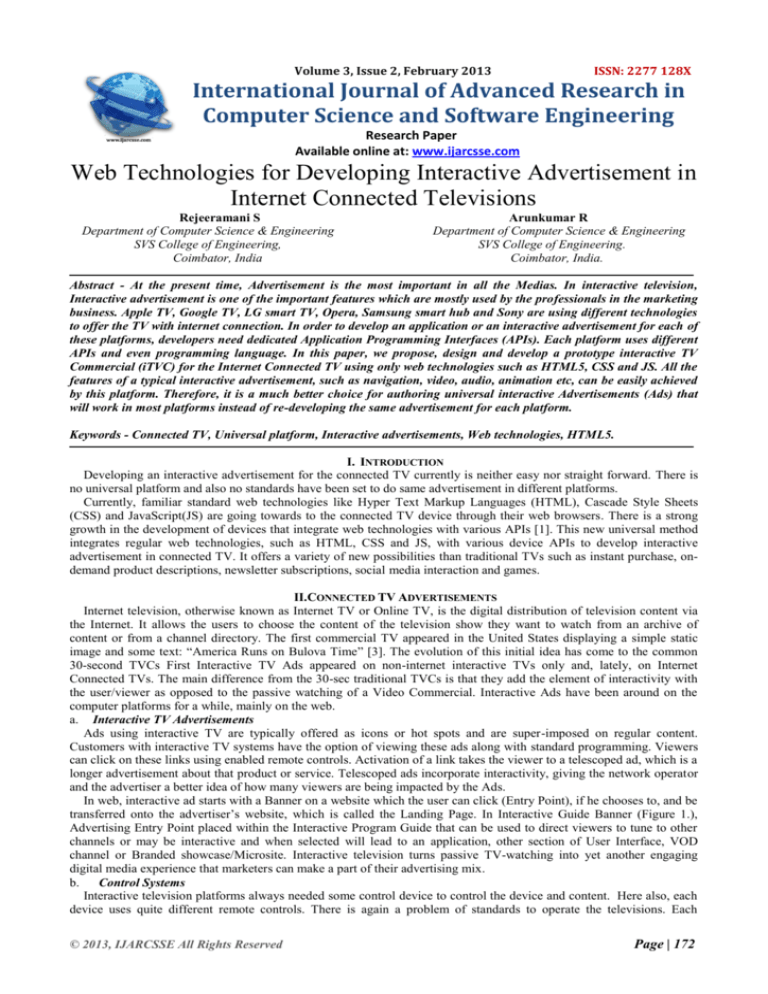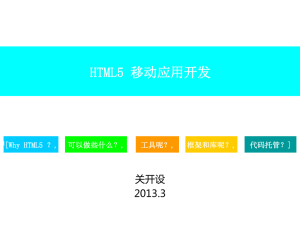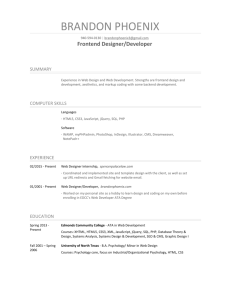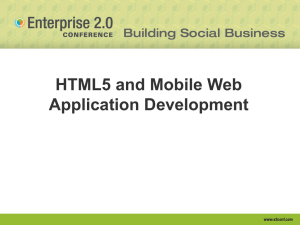
Volume 3, Issue 2, February 2013
ISSN: 2277 128X
International Journal of Advanced Research in
Computer Science and Software Engineering
Research Paper
Available online at: www.ijarcsse.com
Web Technologies for Developing Interactive Advertisement in
Internet Connected Televisions
Rejeeramani S
Department of Computer Science & Engineering
SVS College of Engineering,
Coimbator, India
Arunkumar R
Department of Computer Science & Engineering
SVS College of Engineering.
Coimbator, India.
Abstract - At the present time, Advertisement is the most important in all the Medias. In interactive television,
Interactive advertisement is one of the important features which are mostly used by the professionals in the marketing
business. Apple TV, Google TV, LG smart TV, Opera, Samsung smart hub and Sony are using different technologies
to offer the TV with internet connection. In order to develop an application or an interactive advertisement for each of
these platforms, developers need dedicated Application Programming Interfaces (APIs). Each platform uses different
APIs and even programming language. In this paper, we propose, design and develop a prototype interactive TV
Commercial (iTVC) for the Internet Connected TV using only web technologies such as HTML5, CSS and JS. All the
features of a typical interactive advertisement, such as navigation, video, audio, animation etc, can be easily achieved
by this platform. Therefore, it is a much better choice for authoring universal interactive Advertisements (Ads) that
will work in most platforms instead of re-developing the same advertisement for each platform.
Keywords - Connected TV, Universal platform, Interactive advertisements, Web technologies, HTML5.
I. INTRODUCTION
Developing an interactive advertisement for the connected TV currently is neither easy nor straight forward. There is
no universal platform and also no standards have been set to do same advertisement in different platforms.
Currently, familiar standard web technologies like Hyper Text Markup Languages (HTML), Cascade Style Sheets
(CSS) and JavaScript(JS) are going towards to the connected TV device through their web browsers. There is a strong
growth in the development of devices that integrate web technologies with various APIs [1]. This new universal method
integrates regular web technologies, such as HTML, CSS and JS, with various device APIs to develop interactive
advertisement in connected TV. It offers a variety of new possibilities than traditional TVs such as instant purchase, ondemand product descriptions, newsletter subscriptions, social media interaction and games.
II.CONNECTED TV ADVERTISEMENTS
Internet television, otherwise known as Internet TV or Online TV, is the digital distribution of television content via
the Internet. It allows the users to choose the content of the television show they want to watch from an archive of
content or from a channel directory. The first commercial TV appeared in the United States displaying a simple static
image and some text: “America Runs on Bulova Time” [3]. The evolution of this initial idea has come to the common
30-second TVCs First Interactive TV Ads appeared on non-internet interactive TVs only and, lately, on Internet
Connected TVs. The main difference from the 30-sec traditional TVCs is that they add the element of interactivity with
the user/viewer as opposed to the passive watching of a Video Commercial. Interactive Ads have been around on the
computer platforms for a while, mainly on the web.
a. Interactive TV Advertisements
Ads using interactive TV are typically offered as icons or hot spots and are super-imposed on regular content.
Customers with interactive TV systems have the option of viewing these ads along with standard programming. Viewers
can click on these links using enabled remote controls. Activation of a link takes the viewer to a telescoped ad, which is a
longer advertisement about that product or service. Telescoped ads incorporate interactivity, giving the network operator
and the advertiser a better idea of how many viewers are being impacted by the Ads.
In web, interactive ad starts with a Banner on a website which the user can click (Entry Point), if he chooses to, and be
transferred onto the advertiser’s website, which is called the Landing Page. In Interactive Guide Banner (Figure 1.),
Advertising Entry Point placed within the Interactive Program Guide that can be used to direct viewers to tune to other
channels or may be interactive and when selected will lead to an application, other section of User Interface, VOD
channel or Branded showcase/Microsite. Interactive television turns passive TV-watching into yet another engaging
digital media experience that marketers can make a part of their advertising mix.
b.
Control Systems
Interactive television platforms always needed some control device to control the device and content. Here also, each
device uses quite different remote controls. There is again a problem of standards to operate the televisions. Each
© 2013, IJARCSSE All Rights Reserved
Page | 172
Arun et al., International Journal of Advanced Research in Computer Science and Software Engineering 3(2),
February - 2013, pp. 172-177
platform uses different control systems like Remote with keyboard, Touchpad, Keyboard, TV remote and motion
controller.
c. Distributed Platforms
For years, Interactive Television was talked about by many, but seen by few. In the U.S., ITV had long been relegated
to limited trials in a handful of markets and a snazzy booth at an industry trade show. But competitive pressures have
now compelled the industry’s key players to add an “I” to their “TV” offerings. Internet television systems are very
different from the other platforms. Table 1 shows different distributed platforms.
TABLE 1
SAMPLE DISTRIBUTED SYSTEMS
Satellite:
ITV applications on DirecTV and DISH now available
in 25 million sub homes. It is the largest interactive
“footprint” in the U.S.
*By 2012, DBS subscriber growth will peak at
32MMand an estimated 99% will have ITV STBs
(SNLKagan)
Cable
MSOs prepping systems for ETV EBIF and true way
interactive programming, services and advertising.
*By 2012, ETV-EBIF will reach an estimated 50MM
Cable subscribers & tru2way 34MM (SNLKagan)
Telco
AT&T U-verse and Verizon FiOS have grown to
combined 4.2 million subs, with both promoting ITV –
including weather-on-demand services – as a key
feature.
*By 2012, Telco TV subscriber growth in the US is
projected to hit 10MM subs (SNLKagan)
Internet Connected TV
Consumer electronics companies rolling out Internet
connected TVs, STBS and devices featuring ITV portals
and widgets. LG, Sony, Samsung, Vizio & Toshiba are
introducing HDTVs with Yahoo TV Widgets in 2009.
*By 2012, 65m households worldwide will be able to
use TVs to go online (IMS Research)
d. Entry point and Landing page:
Interactive TV ad has Entry Point and Landing page as two main parts which is similar to commercial TV. Entry
Points are the place within the TV viewing or interactive experience where the viewer is first exposed to the interactive
advertisement.
FIG. 1 INTERACTIVE GUIDE BANNER
Next part is Landing Page/Micro-site. Microsite is a Dedicated Advertiser Location or Virtual Channel. It has
collection of segments (including ads, short form programming, and other elements) presented in a single interface
package around an advertisers targeted message that is promoted in various entry.
© 2013, IJARCSSE All Rights Reserved
Page | 173
Arun et al., International Journal of Advanced Research in Computer Science and Software Engineering 3(2),
February - 2013, pp. 172-177
FIGURE 2. BRANDED SHOWCASES/MICROSITES
III. PROPOSED SOLUTION
To develop interactive ads for TV, there is no universal platform and standards. Currently very difficult to design and
develop iTVCs compatible with all platforms. Ads have to be redesigned for each platform, requiring time, knowledge
and money in order for the Ad to have greater exposure to a wider audience.
In our work we used the latest web technologies ofHTML5, CSS3 and JavaScript to create a single Interactive Ad to
target all different platforms. Additionally, to make it more compatible regardless the limitations of support for some
platforms (e.g. for HTML5), we used a JavaScript detection of features and provide a “fallback strategy” for the missing
features.
The advantages of this solution are:
• Universal cross-platform compatibility.
• Adaption for different input devices (remote controls) can be programmed.
• All the features of current TV Ad platforms can be accurately reproduced with HTML5/CSS3/JS.
• HTML5 has now native video support, a vital feature for a TV Ad [8].
• Personalization, a very interesting and effective feature of iTV Ads [8] can be added.
• It does not require any platform-specific technical Skills: Developers don’t have to learn new
languages/technologies.
• Even more features can be added, such as personalization of ads, multi-lingual, mash-ups (eg. maps, social
plug-ins) etc.
• More control of the Ad can be on the advertiser’s side since the ad can reside on the advertiser’s website.
• Easily setup Analytics for the Ads, as these will reside on a web server and can use normal Web Analytics
services.
IV. INTERACTIVE ADS USING WEB TECHNOLOGIES
Web technologies such as HTML5 allow for much richer, more TV friendly web content, such as video, that can be
embedded and controlled much more easily and without the need for any third-party components [8].
a. HTML5
HTML5, the latest version of the HTML web mark-up language, promises to provide businesses with powerful, crossplatform tools for their web and mobile applications, and give developers an alternative to Adobe’s more popular Flash
environment. Although, mainly for marketing purposes and as advertised by Apple’s Steve Jobs, HTML5 has become the
only strong buzzword to include these new web technology features. So, when a non-technical person refers to HTML5,
it actually means the combination of three main technologies: HTML5 for structure, CSS3 for presentation/style and
JavaScript for Interactivity/Animation. The official latest Editor’s Draft version is published online from W3C [10].
Video: The new <video> tag is probably the most important new feature of HTML5 for the TV. It is possible using
this single tag to embed a video onto the page.
Subtitles: It is very common to have subtitles on different languages or captions with only music as soundtrack. This is
now possible using the Web format and the <track> element. The track element allows authors to specify explicit
external timed text tracks for media elements [10].
Audio: The <audio> tag is similar to video but for playing audio. It is another very important feature that was lacking
in prior versions of HTML. Where, on a PC website, it would be possible to be silent, this is not the case on TV. Most
TV content has some kind of soundtrack, in the form of music, narration or sounds. Audio used to be reproduced on the
web using flash but now it’s embedded into native HTML5.
Canvas: Some argue that the <canvas> tag is the most important new feature of HTML5. It’s basically an area in the
browser where the developer can draw graphics or produce animation using JavaScript with the provided API. Creating
real-time graphics used for animation or game design.
Interaction Design: HTML is a markup language so it does not offer much interactivity on its own. However,
JavaScript can offer all the needed features to add interactivity to the interactive Ads. Using JavaScript is even more
enhanced by the many good-quality libraries, like j-Query, that offer many cross-platform functions for producing the
© 2013, IJARCSSE All Rights Reserved
Page | 174
Arun et al., International Journal of Advanced Research in Computer Science and Software Engineering 3(2),
February - 2013, pp. 172-177
most common functionality with only few lines of code. Some example uses of JavaScript in this context are: Animation,
Key Press captures transition effects etc.
Text / Typography: Written text is also most common form of communication on the traditional web on a PC has a lot
of differences on TV. Text exists on TV should be small chunks of text, usually no more than 2-4 lines and also quite big
font size. New version includes new fonts, beyond the extremely limited 5-6 font with @font-type tag of CSS3 and also
with text effects, so common on TV such as shadows and borders (text-shadow), rotation (box-rotate) and even gradients
and advanced masks (-gradient). Text can also be animated using JavaScript.
Graphics Effects (CSS3):New effects of CSS3, such as shadows, rotation, gradients, opacity etc can be very useful for
the presentation of content in television. Although some may argue that this was also possible in the past using prerendered graphics, it is not the same with the real-time option.
Other Features: HTML5 and CSS3 features are by no means limited to the above. These are however the most
obvious ones to be used for an interactive TV Advertisement. Other features include many new semantic tags for clearer
and more specific content structure, and Local Storage for easily storing values even when the browser is closed or
refreshed. As the Recommendation is not finalized yet, it is still possible for other features to be added (or removed)
before the finalized version.
b. Universal Compatibility
As HTML5 is not a completed framework but a work in progress, not all of its features are supported across all
devices. This is a huge problem for creating a TV Ad that is compatible with all devices, as purposed in this paper.
This problem can be addressed using JavaScript to detect compatible tags for the current browser and provide fallback
strategies for when a feature is not available on the current device. For example, if the particular device lacks video
support using the HTML5 <video> tag, an image could be displayed, or even a flash video, if the device supports it.
Since JavaScript is supported on all devices, this technique will ensure that the Interactive Ad will be viewable across all
platforms.
Use of Fallback solution for unsupported features using Modernizer.js: Since all platforms have their own unique
characteristics, browsers, and, hardware. It is impossible to share the exact same support for HTML5 features. So, it is
important, in order to have a smooth universal experience to use “fallbacks” for features not supported by a device. This
is very easy to accomplish using the java script library “modernizr.js” [12] which can find the features a browser supports
and allows the developer to have alternatives for the unsupported ones. So, for example, if the full-screen video feature is
not supported, an alternative image can be displayed instead of an empty area.
Compatibility and performance: Using this fall back technique, it is possible to make the commercial compatible to
virtually all platforms. However, due to the major differences in the hardware, it is important to also test the iTV Ad to
the actual devices to ensure a smooth user experience, and see its performance. If the performance is not satisfactory,
some features of the Ad may be turned off or adjusted to achieve the optimal user experience on each device.
V. PROTOTYPE iTV COMMERCIAL
As a proof of concept, an iTVC was developed, using only web technologies. As mentioned before, the TV Ad had to
include two parts: (a) The Entry Point, which was chosen to be a Video similar to the traditional 30-second spots but with
the added choice for the viewer to press a button to continue to (b) The Branded Microsite/Landing Page, a website with
information about the product where the user can navigate and see its several features.
a. The “30-second” video calling user to action
Technically, the 30-sec spot is a normal HTML5 page that has a full screen video in the background. It is obtained by
using the new <video> tag, a music soundtrack and some car sound effects using the <audio> tag [9]. The fade-in and
fade-out effects are easily produced using the jQuery library which animates the CSS3 opacity property [11].
During the spot (eg. commercial break) the viewer watches part of the TV spot but he/she has the option to press a
button on the remote control in order to continue to the second part. The button can easily be traced using JavaScript
onKeyPress events. If the user presses the button the commercial will not stop but it will only hide the text “Press [M]
button for more”. It will redirect to another HTML page/file after the end of the 30-second spot: the Landing Page.
b. The Landing Page/micro-site
Technically, landing page is a single HTML5 page with a number of main layers (DIVs) that are hidden or shown
depending on the user’s actions using JavaScript events. Each of these main layers contains all the elements of each
screen. The background for all the screens is a video sequence of time-lapsed clouds in order to have a continuous sense
of motion. It is interesting to note that this feature of background video was not present in any of the commercial
Interactive Ads that have been examined in our research which indicated that maybe this was not feasible in these
platforms. Since it is a new HTML5 feature it is also possible that it will not render on all Connected TV systems. For
each other static graphical element, PNG images were used, in order to include 8-bit transparency that was needed and
positioned with CSS on the appropriate positions.
As not all TV platforms share the same screen resolution, relative width and height HTML/CSS attributes were used
to ensure that the graphics would be scaled accordingly. The menus can be controlled using the arrows on the remote
control, where the KeyPress events are traced with JavaScript and current menu choice is highlighted by changing the
CSS properties of box-shadow and background-color.
© 2013, IJARCSSE All Rights Reserved
Page | 175
Arun et al., International Journal of Advanced Research in Computer Science and Software Engineering 3(2),
February - 2013, pp. 172-177
FIG. 3 30-SEC SPOT IN HTML5
VI.
TESTING ON DIFFERENT PLATFORMS
A small initial number of representative devices were chosen for the tests and, using their web browsers, the web page
containing the ad was opened. The systems that were available for testing were: the Nintendo Wii (Opera browser), a
Windows7 HTPC connected to TV, a Sony Internet TV and a mini-mac running the Boxee internet TV software (also
available as a set-top box). Overall, the system runs smoothly on all the test devices. It worked at its best on the Chrome
HTPC since this browser has probably the most HTML5 features up to date and also provides excellent performance.
Nintendo Wii, was the device with the most unsupported features, and actually one of the main reasons that it was chosen
for this experiment: to test the success of the fallback functions. In this case, the fallback functions worked smoothly and
proved their ability to be able to run the ad on relatively limited systems.
Of course, there differences with the fully-supported version, such as some limitations on CSS3 effects, a somehow
slower performance, and also special keystroke events had to be traced to use the Wii remote. For the next device, the
Sony Internet TV browser was quite limited, and a static background had to appear instead of a video but the system was
functional in overall. Finally, on the Boxee device, the system worked quite smoothly, and the performance was similar
to the Chrome version. The only problems were that it was trickier to run 2 difference files of audio and video
simultaneously and also, since the arrow keys were used by the device for keyboard simulation, different keys had to be
used for navigation. Interactive Ad succeeded in working adequately on all tested devices, while the fallback strategy
proved vital for its success. Some benefits as seen in our research and practically through the prototype were simple
coding without need for specialized tools, Rapid development, Cross-platform compatibility, contains all the elements of
an interactive TV Ad such as video, Audio, interaction, animation, social buttons etc, can be changed at real-time, can
support Analytics.
VII. CONCLUSIONS AND FUTURE WORK
For this paper, we examined the ability of the latest versions of web standard technologies, specifically HTML5, CSS3
and JavaScript, to create complete feature-rich Interactive Advertisements compatible with most Connected TV
platforms. By examining the support features of connected TV platforms for these standards, and seeing a number of
example Interactive TV Ads, it was concluded, that all the required features can be easily and accurately replicated using
these technologies. To test the idea, an example prototype Interactive Ad was developed using the aforementioned web
© 2013, IJARCSSE All Rights Reserved
Page | 176
Arun et al., International Journal of Advanced Research in Computer Science and Software Engineering 3(2),
February - 2013, pp. 172-177
technologies. Forms have been possible even before the latest web-standard versions and, with JS and CSS3 can now
become more user-friendly and appealing. Social Networks include HTML5/JS APIs so these can be included too.
Finally games, although very limited with previous HTML versions, can now be developed with HTML5 and JavaScript,
reaching quality on a par only previously possible with Flash Games.
REFERENCES
[1] W3C, ”Web and TV”, 2011, Available at: http://www.w3.org/standards/webofdevices/tv. Accessed in February,2012.
[2] R. Lawer, “Not just mobile: Adobe is abandoning Flash on TVs as well”, GigaOM, 2011.
[3] J. Sivulka, “Soap, Sex, and Cigarettes: A Cultural History of American Advertising”, Second Edition, 2011, p.196.
[4] Interactive Advertising Bureau, “Glossary of Interactive Advertising Terms v2.0”, Available at:
http://www.iab.net/media/file/GlossaryofInteractivAdvertisingTerms.pdf , Accessed in February, 2012.
[5] DIRECTTV, “Dynamic Ad Unit Campaigns”, Available:http://www.directvadsales.com/Advertising.aspx#0-5.
Accessed inFebruary, 2012.
[6] Rovi Corporation, “Rovi Advertising Service factsheet”, Available at: http://www.rovicorp.com. Accessed in
February, 2012.
[7] YuMe, “Example Ads with YuMe platform”, Available at: http://www.yume.com/content/ad-gallery-connectedtv.
Accessed inFebruary, 2012.
[8] F. Daoust, P. Hoschka, C. Z. Patrikakis, R. S. Cruz, M. S. Nunes, D. S. Osborne, “Towards Video on the Web with
HTML5”, Position Paper, NEM Summit, 2011.
[9] K. Chorianopoulos, G. Lekakos and D. Spinellis, “Intelligent user interfaces in the living room: Usability design for
personalized television applications”, Proceedings of the 2003 International Conference on Intelligent User
Interfaces, 230–232. ACM Press, 2003.
[10] I. Hickson, “HTML5 - a vocabulary and associated APIs for HTML and XHTML”, Editor’s Draft, W3C, 2012,
Available at: http://dev.w3.org/html5/spec/Overview.html
[11] jQuery JavaScript library, Available at: http://jquery.com
[12] Modernizr JS library, Available at: http://modernizr.com
[13] Emmanouil Perakakis, Alina Levinenko, Georghita Ghinea, “HTML5 and Companion Web Technologies as a
Universal Platform for Interactive Internet TV Advertising”, International Conference on Telecommunications and
Multimedia, 2012.
© 2013, IJARCSSE All Rights Reserved
Page | 177



